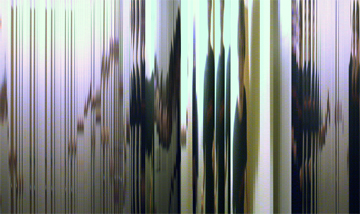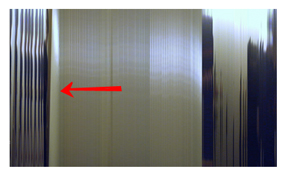2009Spr
M594 DigitalSoundScan
Monica Quinlan
DigitalSoundScan is a video project where time, space, and sound interact in a new way. Viewer interaction alters both the image being created and the ways in which the image is created through movement and noise. A wholly new and unique image is formed each time.

Slit-scan imaging takes time and three-dimensional space, and maps them to a static image. This technique originated with with analogue photography, where a slit shaped shutter can be used to expose different regions of the film at different times. Since then, slit-scan techniques have evolved and are also used in video, digital photography, and digital video.
Using the Processing environment, a new type of slit-scan imaging was created. The Processing code takes live video feed and creates a slit-scan that stacks slices of pixels consecutively to slowly build up an image that maps both time and space. The rate at which these slices are written, as well as their size and spacing, is determined by sound: volume is proportional to the rate of addition to the video. High volume writes quickly, with interruptive "jumps" in the video; silence actually causes the video to rescind its progress and move backwards. This allows one to "see" audio input. Thus, in addition to spatiotemporal mapping, sound is also mapped to a single static image that is continuously built up and written over.
The Sonia Sound Library and JSyn plugin are used in conjunction with Processing to facilitate the sound analysis. Sound input is determined, and progression of video is calculated with an algebraic formula used to further separate differences in noise level. The picture above demonstrates the choppy, uneven effect that can occur. Loud beats in music can be seen as well. This image is continually built from right to left in small slices, and in doing so, writes over the previous image.
 Fig.1: An initial sequence of video stills, showing how the map is built up over time
Fig.1: An initial sequence of video stills, showing how the map is built up over time

Fig. 2: Video still showing the backwards progression of video produced by silence
processing
sonia sound library
jsyn
informal catalogue of slit-scan video and artworks
brendan dawes: don't look now
the fourth dimension